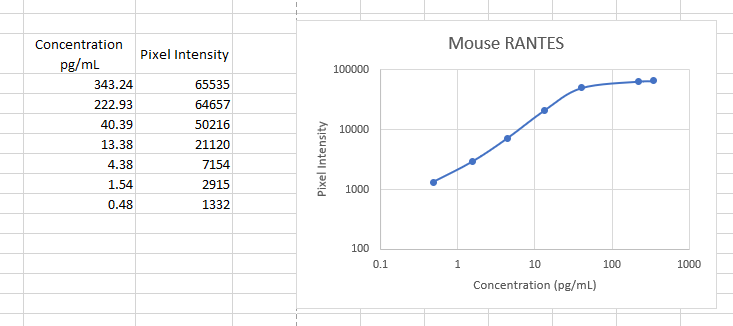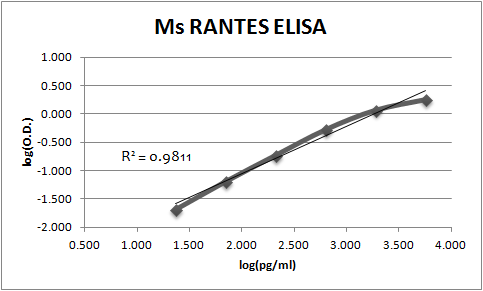Mouse CCL5/RANTES Biotinylated Antibody Summary
Applications
Mouse CCL5/RANTES Sandwich Immunoassay
Please Note: Optimal dilutions should be determined by each laboratory for each application. General Protocols are available in the Technical Information section on our website.
Reconstitution Calculator
Preparation and Storage
- 12 months from date of receipt, -20 to -70 °C as supplied.
- 1 month, 2 to 8 °C under sterile conditions after reconstitution.
- 6 months, -20 to -70 °C under sterile conditions after reconstitution.
Background: CCL5/RANTES
CCL5, also known as RANTES (Regulated upon Activation, Normal T cell Expressed and presumably Secreted), is an 8 kDa beta -chemokine that plays a primary role in the inflammatory immune response by means of its ability to attract and activate leukocytes (1 - 3). Human and mouse RANTES exhibit cross-species activity on human and mouse cells (4). Mature mouse CCL5 shares 100% aa sequence identity with rat CCL5 and 75% - 88% with canine, cotton rat, feline, and human CCL5 (5). CCL5 is secreted by many cell types at inflammatory sites, and it exerts a wide range of activities through the receptors CCR1, CCR3, CCR4, and CCR5 (6, 7). Inflammatory responses can be impaired by the sequestration of CCL5 by the cytomegalovirus protein US28 (8). In humans, CCR5 binding to CCL5 inhibits the infectivity of R5 (M-tropic) but not X4 (T-tropic) strains of HIV-1 (9). The two N-terminal residues of CCL5 can be removed by CD26/DPPIV, generating a protein that functions as a chemotaxis inhibitor and more effectively blocks M-tropic HIV-1 infection of monocytes (10). Oligomerization of CCL5 on glycosaminoglycans is required for CCR1-mediated leukocyte adhesion and activation as well as CCL5’s interaction with the chemokine CXCL4/PF4 (11 - 13). The deposition of CCL5 on activated vascular endothelial cells is crucial for monocyte adhesion to damaged vasculature, but CCL5 oligomerization is not required for the extravasation of adherent leukocytes (14 - 16). CCL5 is upregulated in breast cancer and promotes tumor progression through the attraction of proinflammatory macrophages in addition to its actions on tumor cells, stromal cells, and the vasculature (17).
- Schall, T.J. et al. (1990) Nature 347:669.
- Bacon, K.B. et al. (1995) Science 269:1727.
- Fischer, F.R. et al. (2001) J. Immunol. 167:1637.
- Schall, T.J. et al. (1992) Eur. J. Immunol. 22:1477.
- Heeger, P. et al. (1992) Kidney Int. 41:220.
- Appay, V. and S.L. Rowland-Jones (2001) Trends Immunol. 22:83.
- Levy, J.A. (2009) J. Immunol. 182:3945.
- Randolph-Habecker, J.R. et al. (2002) Cytokine 19:37.
- DeVico, A.L. and R.C. Gallo (2004) Nat. Rev. Microbiol. 2:401.
- Proost, P. et al. (1998) J. Biol. Chem. 273:7222.
- Appay, V. et al. (1999) J. Biol. Chem. 274:27505.
- Proudfoot, A.E.I. et al. (2003) Proc. Natl. Acad. Sci. USA 100:1885.
- von Hundelshausen, P. et al. (2005) Blood 105:924.
- von Hundelshausen, P. et al. (2001) Circulation 103:1772.
- Zernecke, A. et al. (2008) Arterioscler. Thromb. Vasc. Biol. 28:1897.
- Baltus, T. et al. (2003) Blood 102:1985.
- Soria, G. and A. Ben-Baruch (2008) Cancer Lett. 267:271.
Product Datasheets
Citations for Mouse CCL5/RANTES Biotinylated Antibody
R&D Systems personnel manually curate a database that contains references using R&D Systems products. The data collected includes not only links to publications in PubMed, but also provides information about sample types, species, and experimental conditions.
10
Citations: Showing 1 - 10
Filter your results:
Filter by:
-
Development of an Electrochemical CCL5 Chemokine Immunoplatform for Rapid Diagnosis of Multiple Sclerosis
Authors: S Guerrero, E Sánchez-Ti, L Agüí, A González-C, P Yáñez-Sede, JM Pingarrón
Biosensors, 2022-08-07;12(8):.
-
Early growth response 1 deficiency protects host against Pseudomonas aeruginosa lung infection
Authors: Z Pang, R Raudonis, C McCormick, Z Cheng
Infect. Immun., 2019-12-17;0(0):.
Species: Mouse
Sample Types: BALF
Applications: ELISA Detection -
Modulation of double-stranded RNA pattern recognition receptor signaling in ovarian cancer cells promotes inflammatory queues
Authors: M Muccioli, H Nandigam, T Loftus, M Singh, A Venkatesh, J Wright, M Pate, K McCall, F Benencia
Oncotarget, 2018-11-30;9(94):36666-36683.
Species: Human, Mouse
Sample Types: Cell Culture Supernates
Applications: ELISA Development (Detection) -
Nitrosporeusine analogue ameliorates Chandipura virus induced inflammatory response in CNS via NF?b inactivation in microglia
Authors: AK Verma, TS Waghmare, GR Jachak, SC Philkhana, DS Reddy, A Basu
PLoS Negl Trop Dis, 2018-07-12;12(7):e0006648.
Species: Mouse
Sample Types: Protein
Applications: ELISA Development (Detection) -
Regulation of inflammatory factors by double-stranded RNA receptors in breast cancer cells
Authors: A Venkatesh, H Nandigam, M Muccioli, M Singh, T Loftus, D Lewis, M Pate, F Benencia
Immunobiology, 2017-11-22;0(0):.
Species: Mouse
Sample Types: Cell Culture Supernates
Applications: ELISA Development (Detection) -
Cancer cell CCL5 mediates bone marrow independent angiogenesis in breast cancer
Oncotarget, 2016-12-20;0(0):.
Species: Mouse
Sample Types: Cell Lysates
Applications: ELISA Development (Detection) -
KIM-1-mediated phagocytosis reduces acute injury to the kidney.
Authors: Yang L, Brooks C, Xiao S, Sabbisetti V, Yeung M, Hsiao L, Ichimura T, Kuchroo V, Bonventre J
J Clin Invest, 2015-03-09;125(4):1620-36.
Species: Mouse
Sample Types: Cell Lysates
Applications: ELISA Development (Detection) -
Radiation-inducible immunotherapy for cancer: senescent tumor cells as a cancer vaccine.
Authors: Meng Y, Efimova EV, Hamzeh KW
Mol. Ther., 2012-02-14;20(5):1046-55.
Species: Mouse
Sample Types: Whole Tissue
Applications: IHC-P -
Diesel exhaust particulates exacerbate asthma-like inflammation by increasing CXC chemokines.
Authors: Kim J, Natarajan S, Vaickus LJ, Bouchard JC, Beal D, Cruikshank WW, Remick DG
Am. J. Pathol., 2011-10-01;179(6):2730-9.
Species: Mouse
Sample Types: BALF
Applications: ELISA Development -
Synthesis of several chemokines but few cytokines by primed uncommitted precursor CD4 T cells suggests that these cells recruit other immune cells without exerting direct effector functions.
Authors: Mosmann T
Eur. J. Immunol., 2004-06-01;34(6):1617-26.
Species: Mouse
Sample Types: Cell Culture Supernates
Applications: ELISA Development
FAQs
No product specific FAQs exist for this product, however you may
View all Antibody FAQsReviews for Mouse CCL5/RANTES Biotinylated Antibody
Average Rating: 4.7 (Based on 3 Reviews)
Have you used Mouse CCL5/RANTES Biotinylated Antibody?
Submit a review and receive an Amazon gift card.
$25/€18/£15/$25CAN/¥75 Yuan/¥2500 Yen for a review with an image
$10/€7/£6/$10 CAD/¥70 Yuan/¥1110 Yen for a review without an image
Filter by:
Used as detection in ELISA




